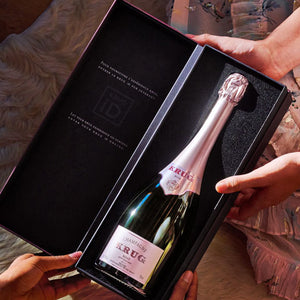
Everything You Need to Know About Rosé
While great for sipping at parks, picnic hangs, and casual gatherings everywhere, rosé wines are actually some of the most versatile and food-friendly bottles on the market (and when produced at the right hands, they can withstand serious bouts of aging in the cellar). Curious to learn more? We’re breaking down everything you need to know about this beloved style of wine here.
What Is Rosé?
Rosé is a pink-hued style of wine made all over the world. It is known—and widely enjoyed—for its bright acidity, absent tannins, and fruit-driven flavor profiles, which render it easy to drink and food friendly.
How Is Rosé Made?
The direct press / skin contact method and saignée methods are the two main ways to produce rosé. Direct press / skin contact involves harvesting red grapes and immediately pressing the juice out of them, then letting the juice macerate with the skins for a certain period of time. The longer the juice spends in contact with the skins, the darker the final hue of the wine will generally be. (Note: French rosé that is produced from direct-pressed fruit with zero to minimal skin contact is often referred to as Vin Gris.)
The saignée method is used during red wine production. During red wine vinification, some producers will choose to “bleed off” (saignée) some juice from their red wine must. This process leads to a darker, more concentrated red wine, as less juice remains in contact with the skins. The bled-off juice is then bottled and sold as rosé.
Simply blending red wine and white wine together for the purpose of making rosé is not permitted in most viticultural regions, save for Champagne, where the majority of rosé wines from the region get their hue from the addition of small amounts of still Pinot Noir.
Where Is Rosé Made?
Rosé is made in nearly every wine-producing region in the world, though its most famous home is in the south of France, particularly within the region of Provence. Elsewhere, rosé wine is quite popular in Champagne, the Loire Valley, Spain (Navarro, Rioja), Italy, California, and beyond.
What Does Rosé Taste Like?
The exact flavor profile of rosé wines is highly dependent on the grape varieties and vinification / aging vessels used, as well as the region from which the wine comes. In general, most dry rosés are fruit-forward, approachable, and easy to drink, thanks to their high amounts of natural acidity and fruit-driven flavor profiles.
Which Foods Pair Best With Rosé?
Because of their high acidity and absence of tannins, rosé pairs well with a plethora of cuisines and dishes. From fresh seafood and salads to Mediterranean-inspired mezze and various appetizers to heartier Asian, Indian, and Mexican cuisines (and don’t forget the classic American barbecue favorites), there’s really not a dish that won’t come to life when enjoyed alongside a glass of rosé.
Can Rosé Age?
Contrary to popular belief, yes! When produced at the hands of stellar producers, structured rosé wines are incredibly suited for aging. While the majority of rosé is meant to be consumed within the first one to three years of the vintage date, benchmark rosés from top Provençal producers (Domaine Tempier, Terrebrune, Clos Cibonne, Clos Ste. Magdeleine), as well as examples from Lopez de Heredia (Rioja, Spain) and top Champagne producers take on a whole new level of complexity after extended time in the cellar.
Is Rosé Enjoyable Beyond the Summer Season?
Yes! Although synonymous with summer, because of their versatility, acid-forward flavor profiles, and food-friendly nature, rosé is simply delightful to enjoy all year long.




